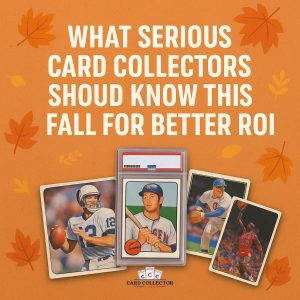As the fall season kicks off, collectors are preparing their sports and trading cards for auctions, sales, and investments. For those focused on sports card investing, understanding ROI drivers like condition sensitivity, grading strategies, and accurate card valuation is essential. In this guide, we’ll break down what serious collectors should know this season to maximize returns, with practical insights from grading to market timing.
Why Fall is a Key Season for ROI

The fall months bring heightened demand across the hobby. Sports schedules overlap; baseball postseason, NFL in full swing, and NBA tip-offs—driving collector interest. Holiday buying also plays a role, as auctions and marketplaces see more active bidders. If you’re considering selling or consigning cards, this season offers unique opportunities to achieve better ROI.
ROI Comparison: Raw vs. Graded
Graded cards consistently outperform raw ones, especially when graded by trusted authorities like PSA. Buyers place greater confidence in slabbed cards because condition, authenticity, and value are certified.
| Card Example | Raw Value | PSA 9 Value | PSA 10 Value | ROI Increase |
| 1989 Upper Deck Ken Griffey Jr. RC | $50 | $160 | $1,500 | Up to 2,900% |
| 2003 Topps Chrome LeBron James RC | $1,200 | $3,800 | $6,000 | Up to 400% |
| 1999 Pokémon 1st Edition Holo Charizard | $3,500 | $8,200 | $20,000+ | Up to 470% |
Based on recent public auction results; values fluctuate by market conditions.
In our experience, even mid-value cards see significant ROI boosts with PSA 9 or PSA 10 grades. That’s why so many collectors turn to our Grading Services before listing for sale.
Condition Sensitivity: Why Grading Matters
Not all cards are created equal. Some sets are notorious for off-centering, chipping, or print defects. Condition-sensitive issues can drastically impact value if left ungraded.
Condition factors serious collectors track:
- Corners & Edges – Clean, sharp cuts hold the most value.
- Centering – Poor centering can reduce a grade by 1–2 levels.
- Surface Quality – Scratches, stains, or print lines significantly lower valuation.
- Autographs – Signatures must be authenticated, and autograph grading can add major ROI.
To understand how grading companies weigh these details, see our full Baseball Card Grading Process guide.
When Grading Pays Off
Grading isn’t necessary for every card, but in many cases, it’s the difference between a modest sale and a standout auction result.
Grading is worth the investment when:
- The card is vintage, rookie, or has historical significance.
- Population reports show scarcity in higher grades.
- You’re preparing for a high-demand auction season.
- The card features an autograph that benefits from authentication.
As a PSA Authorized Dealer, we streamline submissions to save collectors time, reduce shipping risks, and ensure proper handling.
FAQ: Collector Questions This Season
Q: Is it worth grading base cards?
A: Generally only if they’re vintage, rare, or in gem-mint condition. For modern base, ROI may not justify fees unless tied to star rookies.
Q: How far ahead should I grade before selling?
A: Allow at least 6-8 weeks before auction deadlines, factoring in PSA turnaround times.
Q: Does autograph grading really add value?
A: Yes. A card with a PSA/DNA-certified autograph typically sells at a premium over raw signed cards.
Final Thoughts
This fall, maximizing ROI in sports card investing requires more than timing—it demands preparation. Understanding card valuation, grading condition-sensitive cards, and leveraging trusted dealer submission channels can help you unlock your collection’s true potential.
Maximize your return; submit your cards for PSA grading through our authorized dealer service.
